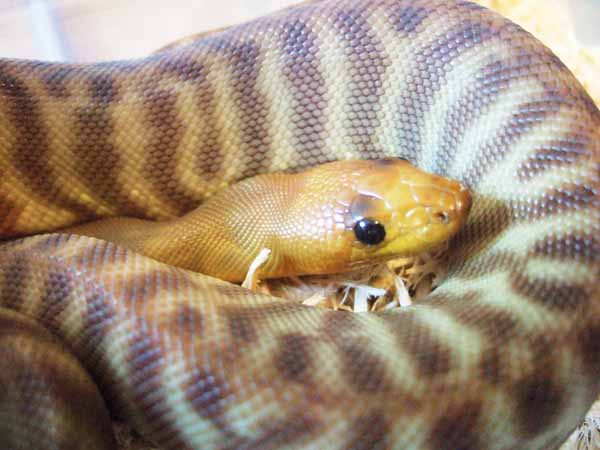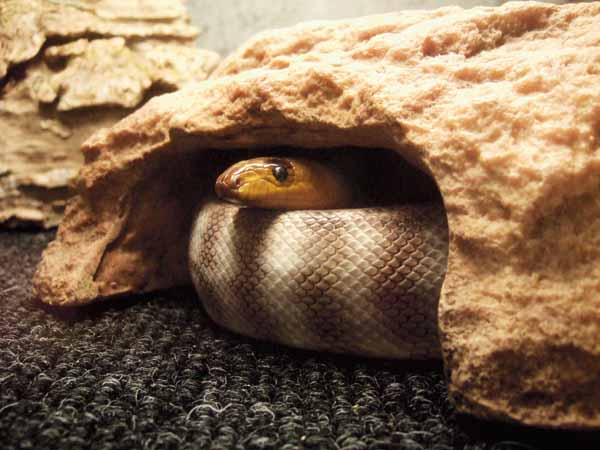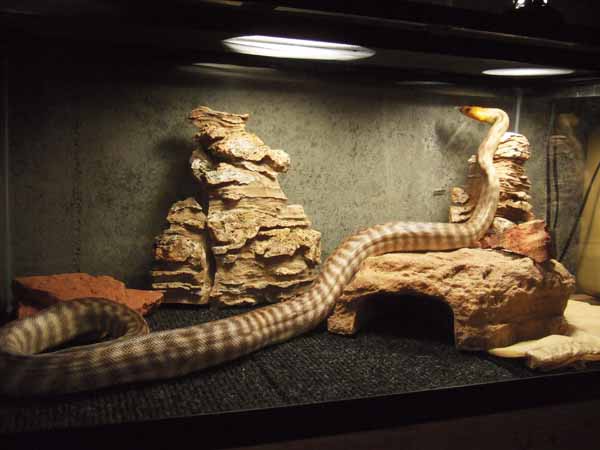Captive care for the forever fascinating woma python.
With more than 40 years of herpetological exploration and experience in most areas of the field, including work with hundreds of herp species, I find it quite amazing to be able to put my finger on a single species that I would forever choose to have in my personal collection. The woma python (often pronounced “why-mah” in its native Australia) is one such species. Rarely have I ever worked with a snake species as predictable and mildly mannered as the gentle woma. Its body is smooth and movements graceful. It is a vision of perfection, and like a fine piece of artwork, it is difficult to look away. It is the one species that I want in my office while I’m trying to work. If stress or tension has my mind blocked and I’m unable to write, watching this beautiful creature always helps me to relax.

Photo by Leo Spinner
Aspidites means “shield-bearer,” and refers to the large scales on a woma’s head.
Nomenclature and Range
First described in 1882 by Australian Zoologist and Naturalist William John Macleay as Aspidites ramsayi (Aspidites meaning “shield-bearer” in relation to the large scales of its head, and ramsayi after Edward Pierson Ramsay, curator for the Australian Museum from 1874 to 1894), the woma python, also known as Ramsay’s python and the sand python, has been on a taxonomic rollercoaster ride ever since. Zoological studies often alluded to the woma being subspecific to its cousin, the black-headed python (A. melanocephalus), and historical taxonomic changes reflected that. As of late, it seems that the powers that be have decided on the Antony J. Underwood and A. F. Stimson change back to A. ramsayi of 1993.
Distributed throughout areas of central and west Australia, woma distribution is notably less solid than the black-headed python. The woma has become extirpated over much of its range from the south and east of southern Australia, and it is currently found in areas of the extreme northwest, from Port Hedland inland east to just beyond Yarrie. In southwest Australia, womas can be found along the coastal plain from just north of Geraldton, south to Perth and inland east to Kalgoorlie. In the southern part of the Northern Territory, it ranges from just north of Tennart Creek, south into the northern portion of South Australia, to Leigh Creek and Broken Hill in New South Wales. To the east, it extends roughly to Toowdomba in Queensland, and north to Mount Isa.
Woma and Black-headed Python
The woma and black-headed pythons are the only two species in the genus Aspidites. The woma occupies arid regions, including red sand desert moderately covered by Spinifex and poverty bush (Acacia translucens), throughout much of Australia. The black-headed python occupies more humid, semitropical environs across northern Australia.

Photo by Leo Spinner
Providing woma's with hides helps them feel more secure.
Womas are primarily nocturnal. During the warmer months, they seek out prey along the surface of the terrain, as well as beneath it within reptile and mammal burrows. These snakes prefer to spend their days out of sight and away from the scorching rays of the sun and marauding predators, hiding beneath grassy mounds, loose sandy substrate and surface debris, or within the dark recesses of their own burrows. The woma is covered in smooth scales, which assist in the reduction of friction as it moves through its scrubland environment.
Relatively small as far as pythons are concerned, the woma averages less than 6 feet in length, with most specimens reaching only 41⁄2 to 51⁄2 feet in overall length. Some from the southern end of the range, however, are known to reach lengths as long as 8 feet and weigh more than 10 pounds.
The woma’s anatomy is indicative of the relatively harsh, dry environment it occupies. Naturally fossorial, a life burrowing beneath the sandy earth and hunting in burrows, as well as a strong passion for feeding on other reptiles, has all but eliminated the need for the external thermal receptive pits commonly found in other snake genera, such as Python. Visible thermal receptive pits are absent, making the genus Aspidites rather unique among pythons, though it has been suggested that womas may indeed possess thermal detection mechanisms within the terminal rostral scale on the face and possibly within the pre-frontals.
The small, darkly colored eyes of the woma are typical of fossorial snakes and not unlike those of the African burrowing pythons of the genus Calabaria, which is comprised of other subterranean species. Over time, the eyes of fossorial animals become reduced or nearly absent due to the reduced light of their environment, as well as a need for the sensitive organs to come into less contact against the animals’ abrasive surroundings.
The woma’s glossy body is covered with small, smooth scales, which become slightly larger along the rear part of the head and abruptly end in the parietal area just behind the eyes, where they continue as large plated scales over the eyes, forehead and along the mouth. Ventrally, the small smooth scales of the back and sides carry along the throat. A thick pattern of dark-chestnut, red or light-brown bands against a lighter beige, gray or silver background color gives the woma a somewhat ominous appearance, one that is sometimes associated with a venomous species. The woma’s bands are typically somewhat disruptive, meeting non-uniformly along the spine and forming a solid stripe or checkerboard pattern. These disruptive bands are almost fuzzy in appearance, due to fading along their edges, and they are discontinuous, stopping along the sides without continuing across the belly, which is yellow, white or gray, often with random darker blotches. Patternless specimens occur, but they are rare (one of only four known resides in a private breeder’s collection in southeastern Pennsylvania).
Another notable visible characteristic of the woma is the dark-brown to black pigmented blotches located above each eye, as well as the rostrum. The head and neck is usually a patternless shade of yellow (intense on some individuals) or yellowish brown, against which these darkened areas may dramatically stand out. Although some individuals describe the woma’s dark eye shadows as menacing or skull-like, I think they provide this beautiful snake more of an ancient-Egyptian vibe and contribute to its elegant appearance.
In nature, most woma sizes and morphs are likely in direct correlation to the variety of food available in specific areas. It is quite variable in nature, with morphs being common and area-specific. One morph, often referred to as colaris or the colaris woma, is recognized by the dark pigmentation surrounding the entire eye and well-defined dark bands over the length of its body.
Woma Python Captive Care
For an exotic snake that is still relatively uncommon in American collections, the woma python demands a rather modest price. Captive-hatched specimens can be found for less than $300, much less than their pricey cousin, the black-headed python. The woma is a rather underrated species in captivity. It is an active snake that takes well to being handled, typically has a ferocious appetite and breeds readily under captive conditions. Womas do not grow to a very large size, but they are not obscure, either.

Photo by Leo Spinner
This is one of the author’s 40-gallon woma enclosures.
Captive husbandry of the woma does not require great skill and will not break you financially. This species adapts well to a variety of captive-maintenance programs, including a natural type of setup that would allow the snake to burrow into sandy soil and have rocks to climb over, or a simple setup of a plastic drawer in a rack system, utilizing newspaper or aspen mulch as substrate. Regardless of the type of captive environment you provide, one common item should always be applied: a hide box. Although womas seem relaxed in most any setting, it is important to remember that this is a nocturnal, burrowing snake, and a pet will fare better with a dark, tight recess in which to retreat.
Womas are active snakes, and it is beneficial to give them a spacious enclosure, but they can be kept modestly. My adult womas are kept in 40-gallon glass tanks, with several large rocks, a heating pad, a large hide box, and commercial, rubber-backed carpeting. Once a week, a water bowl (not large enough to soak in) is left in the enclosure overnight in an effort to keep the humidity level at a preferred 50 to 70 percent. Humidity levels much higher than this may cause irritating skin blisters and promote the growth of dangerous bacteria, which can ultimately lead to scale rot and other discomforts.
It is important for caretakers to execute proper husbandry practices. Remember, even though the woma is from a harsh, arid climate, the majority of this snake’s time is spent in burrows beneath the earth’s surface, where temperatures are notably cooler and constant.
Womas look absolutely stunning under full-spectrum lights. Although such lights are definitely not a requirement for this species, they are highly recommended. It is not necessary to provide a separate heat lamp as long as a heat pad is provided beneath or within the enclosure. It is absolutely essential to provide a woma with a thermal gradient, with a warmer area where your snake can raise its body temperature as well as a cooler area where it can reduce it. Concentrating heat at one end of your snake’s enclosure will create this gradient.
Enclosure temperatures of 79 to 85 degrees Fahrenheit, with a hotspot of 90 degrees, works well with this species. It should be noted that although I stick to these temperatures, other woma keepers have kept their snakes at temperatures that are quite a bit cooler, without ill effect to the snakes.
Enthusiastic Eaters
Captive woma pythons have a reputation as being fabulous feeders on proportionately sized rodents. These snakes rarely refuse food, so don’t overfeed them as they can become obese easily.
Despite this reputation, you may occasionally encounter a woma that refuses to eat, even when the snake is kept under optimal conditions. One such snake — a newly acquired adult female — lives in my collection. She refused food for two months after acquisition. Any number of reasons could have been at play. Although she arrived with great body weight and was very active, the move to the new environment of an open-space glass tank may have disrupted her comfort, as she had been previously kept in a plastic opaque drawer. It is also possible that she may have been in “reproduction mode,” a time when some female snakes are known to go off feed.
The distributor from whom I purchased the snake told me that she was feeding religiously on freshly killed rats, but that she was a little peculiar in her feeding habits. He told me that she needed a live rat to be presented, but then it had to be removed, killed and reintroduced into the enclosure before she would eat it. I tried this method, but the snake still refused to eat.
Ultimately, the only thing that finally stimulated this stubborn woma to feed was my scenting a pre-killed small rat with a bearded dragon. In nature, womas feed extensively on other reptiles, including spiny-tailed monitors (Varanus acanthurus) and snakes, as well as rodents and birds, and the bearded dragon did the trick.
Captive adult womas can be fed rats, mice, chicks and an occasional lizard. Although all of these food items may be accepted, you could also stick with a solid regimen of rodents, if preferred.
Breeding Woma Pythons
Woma pythons can be raised to an adult size of about 4 feet within the first year, but a smaller size is more typical, and they can be bred as early as 2 years old. Adult womas have been observed breeding throughout the year, but females only seem to be biologically receptive during specific times. Although they may be seen copulating, females will not produce eggs every time. A seasonal cooling is beneficial for successful woma breeding. A cooling down around October or November will often stimulate copulation and will lead to successful conception. This cooling can be achieved simply by turning off heating pads at night and allowing ambient high temperatures to drop by 5 degrees, turning your heat pads back on and raising ambient temperatures back to normal each day.
Males can be introduced into a female’s enclosure, and they will continue to breed throughout much of the temperature decrease. Cooling should last three to five months, and you will begin to notice less interaction between your snakes toward the end of the cooling cycle. Males can be removed from the female’s enclosure at this time. Unlike other python species, the female does not appear to ovulate before copulation. Instead, she develops palpable follicles and visible swelling only after successful mating.
Oviposition may not occur for as long as three to five months after successful conception, and adult females may produce anywhere from three to more than 20 relatively large eggs. Like other pythons, female womas tend to lie on their sides or rotate their bellies up shortly before oviposition. This may be necessary for proper orientation of eggs prior to laying.
At this point, the female should be maintained at the standard daytime high temperatures all day long. It is important to have an incubator already prepared and calibrated to the proper temperature of 86 to 89 degrees Fahrenheit, with a preferable constant temperature of 88 degrees. Python breeders should keep in mind that once oviposition occurs, the female will coil around her eggs to incubate them naturally. Problems can be avoided by providing a nest box large enough for the female to move into as oviposition approaches. In a perfect world, this nest box should be large enough to fit directly into your incubator, but for those of you with more modest devices, the eggs will have to gently be removed and placed directly into the heated unit. Great care must be executed in separating a female woma from her eggs, so as not to damage the clutch. It is helpful to have a second person available to help gently uncoil her without interfering with the integrity of the clutch. Gently placing an open hand over the female’s head and neck, while another person maintains her position, will help you gently uncoil her.
Once the female has been removed, the eggs must be placed into the incubating medium in the exact position that they were removed from the original box. Do not turn or rotate the eggs. Separating eggs from one another should be done very carefully to avoid tearing; some breeders prefer to just leave the adhered eggs stuck together inside the incubator.
Creating concave areas to hold separated eggs within the incubating medium will help prevent them from rolling. Cover about two-thirds of each egg, leaving only the top third exposed to the air. The incubation medium should consist of perlite or vermiculite (some breeders use a combination of the two). The incubating medium should be damp but not wet, and it has been suggested by other breeders that actual water can be detrimental to woma egg development.
Offspring
It doesn’t get much cuter than a hatchling woma. These captivating animals begin to pip after 60 to 75 days at optimal incubating temperatures, and they begin feeding readily on neonate rodents after their first shed. Although they are considered super docile, their feeding response can be quite aggressive, so be wary! Occasionally, there is the overly aggressive hatchling that maintains this attitude into adulthood. One such individual, in particular, exists in the extravagant private collection and breeding project of Kyle Rozecki and Sean Jacobs of Pennsylvania, both of whom I owe much respect and thanks for their professional support. In any event, aggressive or not, newly hatched womas can be kept much like your adults. just keep in mind that moisture requirements are a bit higher for hatchlings, and water bowls should be provided continuously. To ensure proper ecdysis, humidity should be raised to 80 to 90 percent when neonates go into a shed cycle.
In Closing
Great things can be said about this amber-colored, red desert jewel. The woma’s suitability as a pet is relatively unmatched in the pet trade. Its great beauty, coupled with a tolerance for handling, great feeding response and moderate size, make the woma a recommended option for any quality herp collection!
LEO SPINNER resides on Cape Cod in Massachusetts and in southeastern Pennsylvania with his children. He owns Skin and Scales exotic reptile presentations, as well as The Spotted Turtle Herpetological Institute of Cape Cod.


